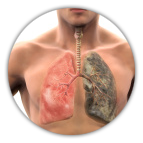

Smoking lowers the bone density leading to higher risk of fractures and osteoporosis.
Smoking causes the accumulation of harmful substances inside the bronchial tubes. The obstruction of small airways in the lung prevents inhaled air from exit, leading to final rupture of the air sacs, causing breathing difficulties. This disease is called emphysema. Patients need to use breathing mask because most lung cells are damaged. Other common smoking related disease is chronic bronchitis, which has similar symptoms as emphysema.


Nicotine affects the nervous system, increases the heart rate and narrows the blood vessels which can elevate blood pressure. Smoking also raises the cholesterol and fibrinogen levels in blood and increases the risk of myocardial infarction and heart attack caused by blood clotting. Other cardiac diseases related to smoking include coronary heart disease, aneurysm, peripheral vascular disease, stroke and etc.
The principal carcinogenic substance in tobacco is tar. Smoking is responsible for many types of deadly cancers including cervical cancer, bladder cancer, cancers of mouth and throat, oesophageal cancer, stomach cancer, liver cancer and leukaemia, etc.


Higher risks of dysmenorrheal, menstrual irregularity and early menopause.